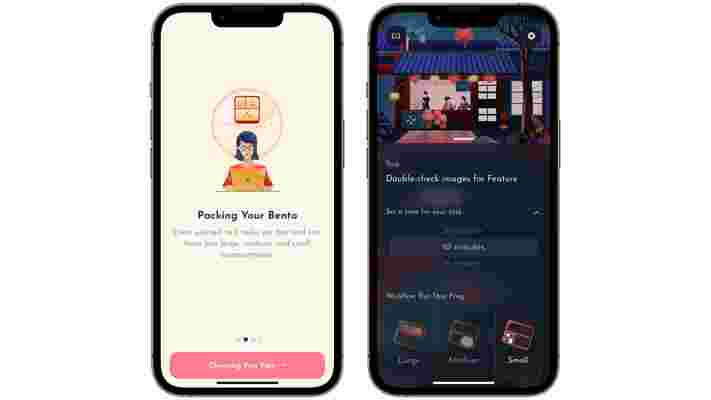There are countless to-do apps on both Apple's App Store and the Google Play Store, but there's never been apps in this category that have focused on the basics - the jobs that are most important for the day ahead.
This is where Bento comes in, an app available for iOS for $5.99 / £4.99 / AU$ 6.99 , and its creators want you to have this either as a companion to popular apps Things 3 and OmniFocus, or as a quick go-to app for the tasks you have for the next few hours.
The app focuses on the Bento methodology - three steps of Pack, Flow, and Focus to help you complete what you need to do. These are then compartmentalized into Bento Boxes, which can help lay out the time needed to achieve the tasks.
Created by the team at Keep Productive , a well-informative YouTube channel for advising you in improving your workflow, the group clearly wants to make sure that it makes an impact in its looks and how it follows the Bento methodology.
With this in mind, we tried it out this week to see how it acted as a companion app for the day.
Doing less in style

Once you launch the app, you're greeted with a helpful introduction to what the Bento method is, followed by a helpful article by the team on using the app further.
The app has a colorful layout that makes it a prime candidate to be both an iPad app, and a screensaver for an Apple TV . Some of the backgrounds you can choose from are animated, adding some extra personality to help make those three tasks more appealing to achieve.
Using Bento over the course of a day, we used it to do a job that we would have otherwise used Things 3 , Reminders, or Notes for. It can be confusing to set a timer on some tasks, as when we tried to, we more often than not arrived at the screen where we would change our Bento, when trying to activate it. If a toggle was here, it could help make the timer more obvious that you can tap something to count down.
But otherwise, it does what it says on the tin, or the Bento box. While there's an Android version on its way, it would be great to see widgets in a future iOS or iPadOS update to better see your Bento boxes.
The design and its color scheme would look great on an iPad Pro, and with its simplicity, a Bento box contained in a widget feels like the natural next step for the team.
What’s the best place to wear a fitness tracker?
What’s the best place to wear a fitness tracker? Modern smart wearables can be worn around the wrist, ankle, finger or neck, within clothing and even inside your shoes. In the face of so much choice, the answer is to spend time working out which fitness tracker (and bodily location) works best for you.
"These days you can get a fitness tracker for pretty much anywhere on your body,” says Issy Towell, wearables expert for London based research and advisory firm CCS Insight . "The market continues to be dominated by the smartwatch, but we've also seen plenty more specialized fitness trackers that cater for more individual consumer needs.”
Ultimately, the best fitness tracker is one that you find comfortable and stylish enough to wear daily – wherever it is on your body. We’ve weighed up the pros and cons of differently placed wearables to help you make your mind up.
Wrist trackers

The majority of fitness trackers are supposed to be worn on the wrist, with their inbuilt accelerometer detecting when a user is active to record movement, heart rate, calories, sleep, stress levels and more.
“This is one of the biggest draws of wrist-worn fitness trackers,” says Towell. “They give you the ability to track a variety of different health metrics using lots of different sensors which can give insights into our stress levels, skin temperature and even our blood oxygen saturation.”
If you like to track a lot of health and fitness data, a wrist wearable can be one of the most user-friendly options. Plus, because they’re so popular, it can be comparatively easy to find a competitively priced model that comes in the kind of style you like.
The drawbacks? “You risk a lot of interference with the signal if you wear it too loose,” says Towell. “The quality of the signal can also be affected by the darkness of your skin tone, and any tattoos.”
Ankle trackers
Ankle trackers record every isolated movement as a step, which in theory should lead to far more accurate data.
Some people also find them more comfortable than wrist wearables, and less prone to slipping around during a sweaty workout. There’s usually no display on the device and, coupled with the fact that it’s further away on your body, ankle wearables can be a great option if you want to try not to obsessively check your stats.
“This could make a good alternative for individuals who prefer not to wear a watch,” says Towell.
Rings
Ring trackers are on the rise, and there are even rumors that an Apple smart ring might be in the works. While the Oura is perhaps the best known smart ring, there are multiple other brands on the market.
So, why choose a smart ring? “They usually have an impressively long battery life of around seven days, compared with around three for most smartwatches,” says Towell.
Rings can also, potentially, deliver more accurate data. Caroline Kryder, Science Communications Lead at Oura, says: "The finger is an ideal place to get a strong signal directly from the arteries. Wrist trackers are far away from the arteries on the underside of the wrist, meaning a signal has to go through bone, muscle, and tissue and can be really muffled by that point.”
In addition, rings can give people with darker skin tones much better accuracy than, for example, wrist tech. “The palm side of the finger is the lightest part of the skin on the body, regardless of skin tone, meaning that users with darker skin are more likely to get an accurate reading with rings,” says Towell.
The downsides? The lack of display on a fitness ring means you need a smartphone and accompanying app to access your stats.

Necklaces
Demand for fitness tracker necklaces is soaring, as more people hunt for fashion-friendly smart wearables. The Bellabeat Leaf is one example of a device that can be worn either on your wrist, or around your neck.
“Fitness tracker necklaces also tend to be battery operated, rather than needing charging, so they can often have a battery life of up to six months,” says Towell.
Unfortunately, most tracker necklaces only give basic sleep and step insights, so they aren’t suitable for anyone who wants to collect complex fitness data.
Vests
Fitness tracker vests (like those from Hexoskin ) hide high tech sensors within clothing (usually in the form of a chest strap) to make a wearable heart rate monitor. They sometimes include GPS, too, which can be useful for outdoor runners.
“Vests tap into a real trend for trying to make fitness trackers less conspicuous,” says Towell. But be wary that tracker vests can also be less accurate, and more prone to picking up interference.

In-shoe trackers
In-shoe trackers come in various forms, including clip-ons, inner soles and foot pods that you can attach to your laces or put inside your trainers.
Wearing a fitness tracker on your feet can give you a really accurate picture of how far and fast you've run, as well as looking at running form and other useful metrics. They also tend to use replaceable watch batteries, which have a lifespan of up to 12 months.
Intelligent insoles in particular are hyped as the next big thing in the fitness tracker industry, with the NURVV Run reportedly able to capture data a thousand times in just one second. The insoles also track cadence, step length, pronation, foot strike and balance, using 32 high precision sensors that work with two inbuilt GPS trackers. Pretty impressive – but they won’t give you a deep dive into your overall health.
The verdict
So, which part of the body comes up trumps? It really depends on what you want.
"If you just want to gain some more insight during your workouts, then an optical heart rate sensor on the wrist is probably sufficient,” says Towell. “But the best place to wear a tracker will be dictated by your individual lifestyle requirements.”
Gran Turismo 7 update pushes its best cars out of your reach
The latest update for Gran Turismo 7 has arrived, but it hasn't been warmly received by the community. The patch drastically reduces the credit payout of races, requiring longer grinds to unlock the game's top cars – pushing players towards microtransactions.
Credits are the basic currency in Gran Turismo 7 , used to purchase new cars, cosmetics, and upgraded components which you can kit out your vehicles with. You can earn them by completing races or, if you’re so inclined, purchase them through microtransactions using real-world cash.
This latest update, however, drastically reduces the number of credits earned by completing races. In some cases, by up to as much as a half. As a Reddit thread details, races like Fisherman’s Ranch have dropped from paying 65k credits to 30k credits; Goodwood’s payout has fallen from 35k to 12k; and Suzuka Circuit’s has been lowered from 75k to 50k. That pattern can be seen across the board, with players recording nearly two dozen races now paying significantly less than they did before the Gran Turismo 7 update 1.07.
Although some of the game’s vehicles will cost you only a few thousand credits, GT7’s Legendary-tier cars will set you back millions. The Alfa Romero 155 costs 800k credits; the Toyota Supra GT500 1.5M credits; and the Ferrari F50 a staggering 3.3M.
Players looking to collect every car in the game, as is the primary challenge of every Gran Turismo, will now have to spend even longer grinding races to rack up the necessary credits.
That grind will inevitably push some towards GT7’s costly microtransactions. You can buy packs of credits through the PlayStation Store, but they don’t come cheap. Four packs are available:

Given the cost of GT7’s cars and the upgrade parts you’ll want to add to your rides, the amount of cash you can spend on the game quickly adds up. And that’s on top of the $89.99 / £69.99 / AU$ $109.95 you’ll have to pay to pick up a copy of the game. Worse, as VGC reported when the game launched, GT7’s microtransactions are also significantly more expensive than its predecessor, Gran Turismo Sport, inflating its in-game expenses even further.
It’s not all bad news though. The update did fix an issue that made it almost impossible for players to beat certain license tests and missions . It also introduces a new Broadcast mode designed for YouTube and Twitch livestreamers. Turn that mode on in the Sound Volume settings, and all music tracks that may trigger copyright infringement will be removed from the game’s BGM playlist.
Analysis: microtransactions are king
This update encourages players to rely on microtransactions to complete their GT7 car collection by arbitrarily restricting the number of credits earned through races. That’s a particularly aggressive strategy that doesn’t sit well in an already expensive videogame.
The changes are particularly infuriating as there was little to suggest the game’s credit payouts needed changing. GT7 players were already finding it challenging to earn enough credits to unlock the game’s top-tier cars. There seems to be little reason for developer Polyphony to have implemented these changes other than to push players towards microtransactions.
It's not going unnoticed by the community either. Players are voicing their anger over the payout changes on GT7’s subreddit. Some who aren’t prepared to stick with the long grind are suggesting they’ll leave the game until payouts are raised to a more reasonable level.
Polyphony’s aggressive use of microtransactions is doubly disappointing in light of GT7’s fabulous core gameplay. In our Gran Turismo 7 review , we said it is “the best entry in the long-running series” that “sets the bar astronomically high for all future racing sims”. Let's hope that isn't soured for long.
